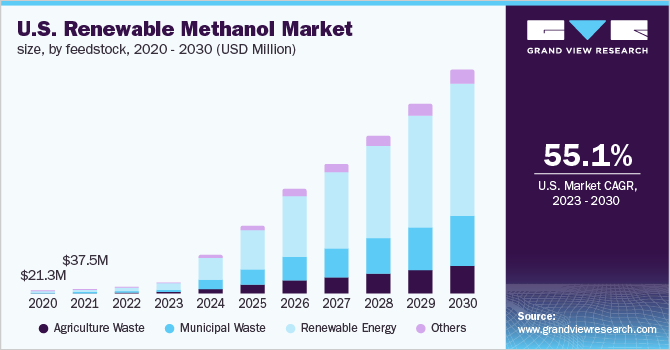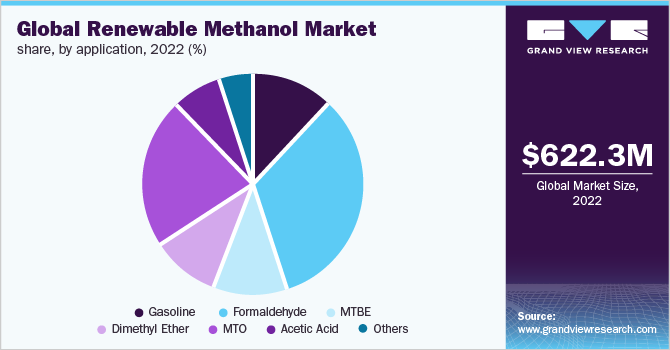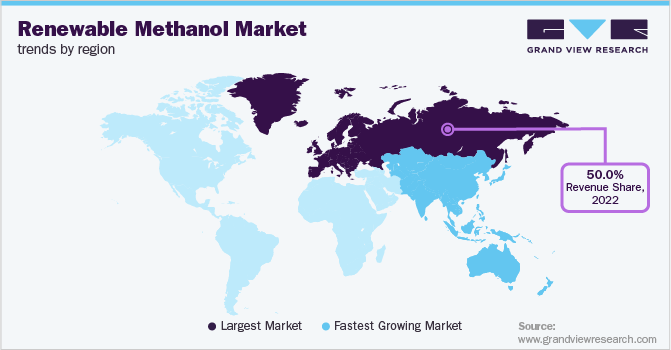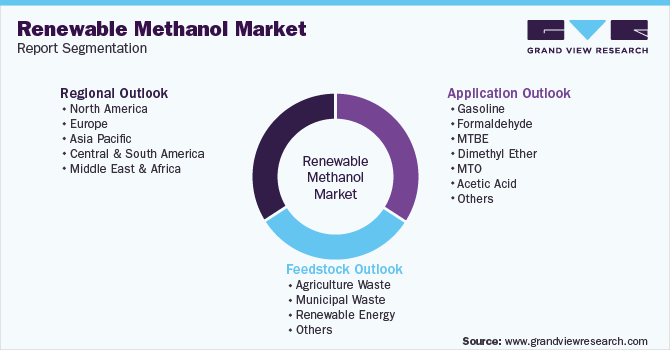- Home
- »
- Renewable Chemicals
- »
-
Global Renewable Methanol Market Size & Trends Report, 2030GVR Report cover
![Renewable Methanol Market Size, Share & Trends Report]()
Renewable Methanol Market (2023 - 2030) Size, Share & Trends Analysis Report By Feedstock (Renewable Energy, Agriculture Waste), By Application (Formaldehyde, MTBE), By Region, And Segment Forecasts
- Report ID: GVR-4-68040-010-8
- Number of Report Pages: 77
- Format: PDF
- Historical Range: 2018 - 2021
- Forecast Period: 2022 - 2030
- Industry: Specialty & Chemicals
- Report Summary
- Table of Contents
- Segmentation
- Methodology
- Download FREE Sample
-
Download Sample Report
Renewable Methanol Market Summary
The global renewable methanol market size was estimated at USD 622.26 million in 2022 and is anticipated to reach USD 20.68 billion by 2030, growing at a CAGR of 55.0% from 2023 to 2030. This is attributed to the growing utilization of renewable methanol in formaldehyde and mineral turpentine oil (MTO) as they are considered prominent chemical compounds in the chemical industry and are widely used in paints and coatings, agrochemicals, cosmetics, food, and pharmaceuticals.
Key Market Trends & Insights
- Europe dominated the market with a revenue share of over 50.0% in 2022.
- Asia Pacific is one of the emerging markets in terms of product consumption.
- By feedstock, renewable energy dominated the market with a revenue share of over 60.0% in 2022.
- By application, formaldehyde dominated the market with a revenue share of over 30.0% in 2022.
Market Size & Forecast
- 2022 Market Size: USD 622.26 Million
- 2030 Projected Market Size: USD 20.68 Billion
- CAGR (2023-2030): 55.0%
- Europe: Largest market in 2022
- Asia Pacific: Fastest growing market
The substitution of marine fuels with renewable methanol and stringent government regulations to reduce greenhouse gas emissions have contributed to the market growth. Increasing demand for renewable methanol is anticipated to boost the market demand during the forecast period owing to its uses in the chemical industry, including acetic acid, formaldehyde, and plastics. The amount of biomethanol used to make polyethylene and polypropylene has increased significantly. Additionally, biomethanol is primarily used as fuel for automobiles, ships, commercial boilers, and kitchen appliances. The fuel can be used as-is, in combination with gasoline to make biodiesel, or as methyl tert-butyl ether (MTBE) and dimethyl ether (DME).
Biomethanol plays a major role in reducing the carbon emission of multiple sectors where possibilities are restricted, especially as feedstock in the chemical industry or as a fuel for road or marine transport. In addition, strict government regulations on carbon dioxide and other greenhouse gas emissions are projected to propel market growth. Further, new policies in Europe’s Emissions Trading System are expected to drive renewable energy sources, thus boosting the market growth. Some of the organizations such as the Fuel Quality Directive, the Air Quality Directive, and the Alternative Fuel Infrastructure Directive of the European region have laid regulations and promoted the consumption of the product across European countries.
The need to significantly reduce or eliminate CO2 emissions in order to mitigate climate change and the growing focus on keeping the average global temperature rise to no more than 1.5°C are the driving forces behind the market growth. This implies that by the middle of the century, emissions across the entire economy will be net zero. As a feedstock in the chemical industry or as a fuel in land or sea transportation, biomethanol has played a larger role in reducing carbon emissions in some sectors where options are currently limited.
Feedstock Insights
Renewable energy dominated the market with a revenue share of over 60.0% in 2022. This is attributed to the increasing production of renewable electricity from hydro sources, wind power, and geothermal electricity. Further, increasing industrialization activities coupled with expanding residential infrastructure development across emerging economies of Asia Pacific, Central America, and the Middle East have led to the heavy generation of CO2 from the industrial sectors, which further boosted the growth of renewable methanol globally.
Hydroelectric, geothermal, and wind electricity are most commonly utilized for production. In terms of methanol production through wind energy, first carbon dioxide is obtained through direct air capture, and thereafter power to methanol efficiency is kept at 50%. Desirable product is thereafter formed using the electricity and electrolysis of water. This process is typically adopted by industry participants due to the availability of renewable electricity and cost-effective production.
Other feedstocks for bio-methanol include biomass, municipal industrial wastes and effluents, and carbon dioxide. The greenhouse emissions of renewable methanol are about 65% to 95% lower compared to conventional methanol and the emission rates vary depending on the raw material utilized and the production process adopted.
Municipal solid waste is among the key feedstock utilized to produce renewable methanol. Municipal wastes include everyday discarded items from households, which are collected and treated to produce the end product. Enerkem is one of the largest Canadian manufacturers of biomethanol from municipal solid waste. The waste to methanol production process is cost-effective and the return on investment is high and quicker as compared to other processes. These factors are anticipated to pave way for large-scale renewable methanol production from municipal solid wastes globally.
Application Insights
Formaldehyde dominated the market with a revenue share of over 30.0% in 2022. This is attributed to its wide range of industrial applications, including cosmetics, paints, and preservatives in the food sector. Along with formaldehyde, renewable methanol has become an integral component and a backbone for the majority of chemical products formulated today.
Methyl-t-Butyl Ether is a widely used component in fuel for gasoline-driven engines and therefore has significant applications in the global transportation sector. Methyl-t-Butyl Ether is a group of oxygenates that is produced by using biomethanol. MTBE has been an important component in fuels since the introduction of the Energy Policy Act in 2005, wherein the requirement for oxygenate was removed for reformulated gasoline. Constant government support to reduce emissions through fuel consumption, coupled with innovations in the field of renewable sources to produce fuel, led to high demand for the product, which, in turn, is projected to drive the market globally in the foreseeable future.

The global demand for gasoline increased in the past couple of decades on account of increased transportation due to commercial and personal purposes. Increasing cross-border trades paved significant opportunities for the maritime industry, which demands a high volume of gasoline. Further, the transportation sector has made immense transformations in terms of fuel-efficient vehicles, simultaneously causing lower environmental hazards. These factors led to high demand for renewable methanol in gasoline blends and the trend is likely to reflect steady growth over the coming years.
Regional Insights
Europe dominated the market with a revenue share of over 50.0% in 2022. This is attributed to increasing production plants in the region due to the increasing need for renewable methanol from application industries such as transportation and automobile in the region. Europe pose a substantial market for renewable methanol since the introduction of the biofuel policy in the region in 2003, which set regulations and obligations to utilize 10% of renewable energy in the transportation sector of the region.
Asia Pacific is one of the emerging markets in terms of product consumption. The region’s economy is largely driven by the growing transportation sector, which drives demand for the product for gasoline applications. In Asia Pacific, China is one of the most crucial markets for renewable methanol across the Asia Pacific as well as from a global standpoint. The country faces two major modernization problems, which include air pollution and energy security, which are the key factors driving demand for renewable methanol in the country.

The native government is focusing on developing and strengthening its renewable energy sources such as tidal energy, geothermal energy, and wind power, which are key aspects of formulating the product. The majority of the product is utilized in the transportation and logistics sector as gasoline blends and the trend is likely to drive the demand over the coming years.
India is a substantially growing market in terms of renewable methanol consumption due to the high demand for fuel-efficient vehicles, thus causing substantially lower emissions. Further, with the rapid development of the plastics and solvents markets in the country due to a surge in industrial activities, coupled with the growth of the automotive and construction sectors, the demand for the product is anticipated to grow over the years. With the rapid penetration of chemical factories in the country on account of low labor charges and abundance of land for industry setup, the demand for these solvents and plastics is increasing at a substantial rate. This is anticipated to pave way for higher demand for renewable methanol in the country.
Key Companies & Market Share Insights
The market is competitive as a large number of companies are trying to enter the market. To meet the rising demand from the end-use industries, manufacturers are increasingly focusing on increasing the capacity of renewable methanol production. These manufacturers continuously conduct R&D activities in order to create a variety of high-quality product lines.
Multiple manufacturers are looking to expand their production capacities. For instance, Maersk entered into strategic partnerships with six companies in March 2022 to increase the global production capacity of green methanol with the aim of sourcing at least 730,000 tons/year by the end of 2025. Some prominent players in the global renewable methanol market include:
-
Advanced Chemical Technologies
-
BASF SE
-
Carbon Recycling International
-
Enerkem
-
Fraunhofer
-
Innogy
-
Nordic Green
-
OCI N.V.
-
Sodra
-
Uniper SE
-
Vertimass LLC
Renewable Methanol Market Report Scope
Report Attribute
Details
Market size value in 2023
USD 1.05 billion
Revenue forecast in 2030
USD 20.68 billion
Growth Rate
CAGR of 55.0% from 2023 to 2030
Base year for estimation
2022
Historical data
2018 - 2021
Forecast period
2023 - 2030
Quantitative units
Revenue in USD million/billion, volume in kilotons, and CAGR from 2023 to 2030
Report coverage
Revenue forecast, volume forecast, company ranking, competitive landscape, growth factors, and trends
Segments covered
Feedstock, application, region
Regional scope
North America; Europe; Asia Pacific; Central & South America; Middle East & Africa
Country scope
U.S.; Canada; Mexico; Germany; Belgium; France; Italy; Spain; Netherlands; Denmark; China; India; Japan; ASEAN; Brazil; Chile
Market Leaders
Advanced Chemical Technologies; BASF SE; Carbon Recycling International; Enerkem; Fraunhofer; Innogy; Nordic Green; OCI N.V.; Sodra; Uniper SE; Vertimass LLC
Customization scope
Free report customization (equivalent up to 8 analysts working days) with purchase. Addition or alteration to country, regional & segment scope.
Pricing and purchase options
Avail customized purchase options to meet your exact research needs. Explore purchase options
Global Renewable Methanol Market Segmentation
This report forecasts volume and revenue growth at the global, regional, and country levels and provides an analysis of the latest industry trends and opportunities in each of the sub-segments from 2018 to 2030. For this study, Grand View Research has segmented the global renewable methanol market report based on feedstock, application, and region:

-
Feedstock Outlook (Volume, Kilotons; Revenue, USD Million, 2018 - 2030)
-
Agriculture Waste
-
Municipal Waste
-
Renewable Energy
-
Others
-
-
Application Outlook (Volume, Kilotons; Revenue, USD Million, 2018 - 2030)
-
Gasoline
-
Formaldehyde
-
MTBE
-
Dimethyl Ether
-
MTO
-
Acetic Acid
-
Others
-
-
Regional Outlook (Volume, Kilotons; Revenue, USD Million, 2018 - 2030)
-
North America
-
U.S.
-
Canada
-
Mexico
-
-
Europe
-
Germany
-
Belgium
-
France
-
Italy
-
Spain
-
Netherlands
-
Denmark
-
-
Asia Pacific
-
China
-
India
-
Japan
-
ASEAN
-
-
Central & South America
-
Brazil
-
Chile
-
-
Middle East & Africa
-
Frequently Asked Questions About This Report
b. The global renewable methanol market size was estimated at USD 622.26 million in 2022 and is expected to reach USD 1.05 billion in 2023.
b. The global renewable methanol market is expected to grow at a compound annual growth rate of 55.0% from 2023 to 2030 to reach USD 20.68 billion by 2030.
b. Europe dominated the renewable methanol market with a share of 50.32% in 2022. This is attributable to increasing production plants in the region due to increasing requirement for renewable methanol from application industries like transportation and automobile industry in the region.
b. Some key players operating in the renewable methanol market include Advanced Chemical Technologies, BASF SE, Carbon Recycling International, Enerkem, Fraunhoffer, Innogy, Nordic Green, OCI N.V., Sodra, Uniper SE and Vertimass LLC
b. Key factors that are driving the market growth include increasing usage of renewable methanol in the chemical industry, including acetic acid, formaldehyde, and plastics.
Share this report with your colleague or friend.
Need a Tailored Report?
Customize this report to your needs — add regions, segments, or data points, with 20% free customization.

ISO 9001:2015 & 27001:2022 Certified
We are GDPR and CCPA compliant! Your transaction & personal information is safe and secure. For more details, please read our privacy policy.
Trusted market insights - try a free sample
See how our reports are structured and why industry leaders rely on Grand View Research. Get a free sample or ask us to tailor this report to your needs.










